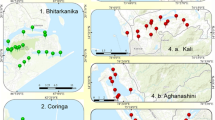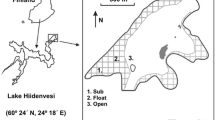Abstract
Phosphorus content in sediment, water and tissues of three macrophyte species growing in Myall Lake, Australia were studied from January to November, 2004. The sites investigated were North–West (NW), North–East (NE), South–West (SW) bays and Central deep area of the lake (CL). The objective of this study was to investigate how total phosphorus (TP) in plant tissues relate to phosphorus pools and the role played by the aquatic macrophyte species under investigation in phosphorus recycling in the lake. Of the four investigated sites of the lake, TP in plant tissues were significantly higher in North–West and South–West bays compared to the rest. Najas marina had significantly higher TP content (e.g., 1.55 and 1.44 mg/g dw.; P < 0.05) for NW and SW respectively, than the other two species. N. marina is a rooted macrophyte while charophytes (C. fibrosa and Nitella hyalina) are pseudo-rooted macrophytes. Total phosphorus in the sediment and water column were significantly higher in Central deep area of the lake compared to the other three bays (P < 0.05, n 5). Soluble reactive phosphorus (SRP) and total dissolved phosphorus (TDP) in sediment pore water correlated significantly with phosphorus content in the tissue of N. marina ( \(r^{2}_{{\rm SRP}-N.\ marina}=0.95\); \(r^{2}_{{\rm TDP}-N.\ marina}=0.92\)) as well as TP in sediment (␣\(r^{2}_{\rm SRP-TP}=0.90\) and \(r^{2}_{\rm TDP-TP}=0.81\)). Using the two-compartmental uptake model, it was observed that, sediment was the main compartment through which Ni. hyalina obtained phosphorus while for the other two species, water column was the uptake route for the phosphorus. These correlations suggest that, water column and sediments are important pathways for phosphorus uptake in plants.
Similar content being viewed by others
References
Abdo MSA, Da Silva CJ (2002) Nutrient stock in the aquatic macrophytes Eichhornia crassipes and Pistia stratiotes in the Pantanal, Brazil. In: Lieberei R, Bianchi HK, Boehm V, Reisdorff C (eds) Neotropical Ecosystems, Proceedings of the German-Brazilian Workshop. Hamburg 2000, GKSS-Geesthacht, Germany, pp 875–880
APHA, AWWA, WPCF (1995) Standard methods for the examination of water and wastewater. 18th edn. American Public Health Association, Washington, DC
Barko JW, James WF (1998) Effects of submerged aquatic macrophytes on nutrient dynamics, sedimentation, and resuspension. In: Jeppesen E, Søndergaard M, Søndergaard M, Christoffersen K (eds) The structuring role of submerged macrophytes in Lakes. Springer, New York, pp 197–214
Barko JW, Gunnison D, Carpenter SR (1991) Sediment interactions with submersed macrophyte growth and community dynamics. Aquat Bot 41:41–65
Barko JW, Smart RM (1980) Mobilization of sediment phosphorus by submerged freshwater macrophytes. Freshwat Biol 10:229–238
Blindow I (1992) Decline of charophytes during eutrophication: comparison with angiosperms. Freshwat Biol 28:9–14
Borum J (1996) Shallow coastal areas—land/sea boundaries. In: Jørgensen BB, Richardson K (eds) Eutrophication in a coastal marine environment. Coastal and estuarine studies, vol 52. American Geophysical Union, Washington DC, pp 179–203
Caetano M, Falcao M, Vale C, Bebianno M (1997) Tidal flushing of ammonium, iron and manganese from inter-tidal sediment pore waters. Mar Chem 58:203–211
Carignan R, Kalff J (1980) Phosphorus sources for aquatic weeds: water or sediment? Science 207:987–989
Carpenter SR (1998) Enrichment of Lake Wingra, Wisconsin, by submerged macrophyte decay. Ecology 61:1145–1155
Clarke JS, Wharton G (2001) Sediment nutrient characteristics and aquatic macrophytes in lowland English rivers. Sci Tot Environ 266:103–112
Coelho JP, Flindt MR, Jensen HS, Lillebø AI, Pardal MA (2004) Phosphorus speciation and availability in intertidal sediments of a temperate estuary: relation to eutrophication and annual P-fluxes. Estuar Coastal Shelf Sci 61:583–590
Da Silva CJ, Walnut F, Esteves FA (1994) Chemical composition of the main species of aquatic macrófitas of the Lake Recreation, Pantanal Matogrossense (TM). Rev Brazil Biol 54(4):617–622
Denny P (1972) Sites of nutrient absorption in aquatic macrophytes. J Ecol 60:819–829
DLWC (1998) Liverpool plains water quality project. 1996/98 report on nutrients and general water quality monitoring. Department of Land and Water Conservation, Sydney, p 56
Duarte CM (1992) Nutrients concentration of aquatic plants: patterns across species. Limnol Oceanogr 37:882–889
Farias L, Chuecas, L, Salamanca, MA (1996) Effect of coastal upwelling on nitrogen regeneration from sediment and supply of ammonium to water column to Concepcion Bay, Chile. Estuar Coastal Shelf Sci 43: 137–155
Fujita RM, Wheeler PA, Edwards RL (1989) Assessment of macroalgal nitrogen limitation in a seasonal upwelling region. Mar Ecol Prog Ser 53:293–303
Gerloff GC, Krombholz PH (1966) Tissue analysis as a measure of nutrient availability for the growth of angiosperm aquatic plants. Limnol Oceanogr 11:529–537
Godshalk GL, Barko JW (1985) Vegetative succession and decomposition in reservoirs. In: Gunnison D (eds) Microbial processes in reservoirs. Dr W Junk Publishers, Dordrecht, Netherlands, pp 59–78
Harris GP (1999) Comparison of the biogeochemistry of lakes and estuaries: ecosystem processes, functional groups, hysteresis effects and interaction between macro and microbiology. Mar Freshwat Res 50:791–811
Harris GP (2001) Biogeochemistry of nitrogen and phosphorous in Australian catchments, rivers and estuaries: effects of land use and flow regulation and comparisons with global patterns. Mar Freshwat Res 52:139–149
Hough RA, Wetzel RG (1975) The release of dissolved organic carbon from submerged aquatic macrophytes: diel, seasonal, and community relationships. Verh Internat Verein Limnol 19:939–948
Howard-Williams C, Allanson BR (1981) Phosphorus cycling in a dense Potamogeton pectinatus L bed. Oecologia 49:56–66
Hupfer M, Dollan A (2003) Immobilisation of phosphorus by iron-coated roots of submerged macrophytes. Hydrobiologia 506–509:635–640
James WF, Barko JW, Eakin HL (2002) Phosphorus Budget and Management Strategies for an Urban Wisconsin Lake. Lake Reservoir Manage 18:149–163
James WF, Barko JW, Eakin HL, Helsel DR (2000) Distribution of sediment phosphorus and fluxes in relation to alum treatment. J Am Water Resour Assoc 36(3):647–656
James WF, Barko JW (1997) Effects of submersed macrophytes on nutrient dynamics, sedimentation and resuspension. In: Jeppesen E, Søndergaard M, Christoffersen K (eds) The structuring role of submersed macrophytes in Lakes. Spring-Verlag, NY, pp 7:1–9
Jensen HS, Thamdrup B (1993) Iron-bound phosphorus in marine sediments as measured by bicarbonate–dithionite extraction. Hydrobiologia 253:47–59
Kufel L, Kufel L (2002) Chara beds acting as nutrient sinks in shallow lakes a review. Aquat Bot 72:249–260
Littlefield L, Forsberg C (1965) Absorption and translocation of phosphorus by Chara globularis Thuill. Physiologia Plantarum 18:291–296
Mortimer C (1941) The exchange of dissolved substances between mud and water in lakes I. J Ecol 29:280–329
Mortimer C (1942) The exchange of dissolved substances between mud and water in lakes II. J Ecol 30:147–201
Muphy J, Riley JP (1962) A modified single solution method for the determination of phosphate in natural waters. Anal Chim Acta 27:31–36
Nguyen L, Sukias J (2002) Phosphorus fractions and retention in drainage ditch sediments receiving surface runoff and subsurface drainage from agricultural catchments in the North Island, New Zealand. Agric Ecosys Environ 92(1):49–69
Ozimek T, Van Donk E, Gulati RD (1993) Growth and nutrient uptake by two species of Elodea in experimental conditions and their role in nutrient accumulation in a macrophyte-dominated lake. Hydrobiologia 251:13–18
Palma-Silva C, Albertoni EF, Esteves FA (2004) Charophytes as nutrient and energy reservoir in a tropical coastal lagoon impacted by humans. Braz J Biol 64(3):479–487
Pedersen MF, Borum J (1996) Nutrient control of algal growth in estuarine waters. Nutrient limitation and the importance of nitrogen requirements and nitrogen storage among phytoplankton and species of macroalgae. Mar Ecol Prog Ser 142:261–272
Prentki RT, Adams MS, Carpenter SR (1979) Role of submersed weed beds in internal loading and interception of allochthonusus materials in Lake Wingra. Arch Hydrobiol 57:221–250
Prentki RT (1979) Depletion of phosphorus from sediment colonized by Myriophyllum spicatum L. In: Breck JE, Prentki RT, Loucks OL (eds) Aquatic plants, lake management, and ecosystem consequences of lake harvesting. Institute for Environmental Studies, University of Wisconsin, Madison, WI, pp 161–176
Scheider S, Melzer A (2004) Sediment and water nutrient characteristics in patches of submerged macrophytes in running waters. Hydrobiologia 527:195–207
Schneider S, Melzer A (2003) The trophic Index of macrophytes (TIM)—a new tool for indicating the trophic state of running waters. Int Rev Hydrol 88:49–67
Schindler DW (1977) Evolution of phosphorus limitation in lakes. Science 195:260–262
Schuette HA, Alder H (1929) A note on the chemical composition of Chara from green lake, Wisconsin. Trans Wis Acad Sc Lett 24:141–145
Shilla D, Asaeda T, Fujino T, Sanderson B (2006) Decomposition of dominant submerged macrophytes: implications for nutrient release in Myall Lake, NSW, Australia. Wetlands Ecol Manage 1–7
Siong K, Asaeda T (2006) Does Calcite encrustation in Chara provide a phosphorus nutrient sink? J Environ Qual 35:490–494
Smith VH, Tilman GD, Nekola JC (1999) Eutrophication: impacts of nutrient inputs to freshwater, marine and terrestrial ecosystems. Environ Pollut 100:179–196
Smith CS, Adams MS (1986) Phosphorus transfer from sediments by Myriophyllum spicatum. Limnol Oceanogr 31:1312–1321
Søndergaard M (1981) Kinetics of extracellular release of 14C-labelled organic carbon by submerged macrophytes. Oikos 36:331–347
Søndergaard M (1988) Seasonal variation in the loosely sorbed phosphorus fraction of the sediment of a shallow and hypereutrophic lake. Environ Geol Water Sci 11:115–121
Søndergaard M, Jensen JP, Jeppesen E (1999) Internal phosphorus loading in shallow Danish lakes. Hydrobiologia 408/409:145–152
Thiebaut G, Muller S (2000) Linking phosphorus pools of water, sediment and macrophytes in running waters. Ann Limnol Int J Lim 39(4): 307–316
Topa MA, Sisak CL (1997) Characterization of phosphorus uptake in slow and fast-growing southern pine seedlings grown in solution culture. Plant Soil 190(2):317–329
Waite TD (1984) Principles of water quality. Academic Press, Orlando
Wald A (1939) Contributions to the theory of statistical estimation and testing hypotheses. Ann Math Stat 10:299–326
Wetzel RG (1996) Benthic algae and nutrient cycling in lentic freshwater ecosystems. In: Stevenson RJ, Bothwell ML, Lowe RL (eds) Algal ecology in freshwater benthic ecosystems. Academic Press, San Diego, pp 641–669
Wile I (1975) Lake restoration through mechanical harvesting of aquatic vegetation. Verh Internat Verein Limnol 19:660–671
Wilson J (2004) The effect of runoff event on the ecology and chemistry of Myall Lakes: Changes in water quality, nutrients and phytoplankton assemblages. Department of Infrastructure, Planning and Natural resources. Centre for natural resources, Parramatta, pp 1–38
Wu P et al. (2001) QTLs and epistasis for activity of acid phosphotase under P sufficient and deficient conditions in rice. Plant Soil 230:99–105
Young WJ, Marston FM, Davis JR (1996) Nutrient exports and land use in Australian catchments. J Environ Manage 47:165–183
Author information
Authors and Affiliations
Corresponding author
Rights and permissions
About this article
Cite this article
Shilla, D.A., Asaeda, T., Kian, S. et al. Phosphorus concentration in sediment, water and tissues of␣three submerged macrophytes of Myall Lake, Australia. Wetlands Ecol Manage 14, 549–558 (2006). https://doi.org/10.1007/s11273-006-9007-5
Received:
Accepted:
Published:
Issue Date:
DOI: https://doi.org/10.1007/s11273-006-9007-5




